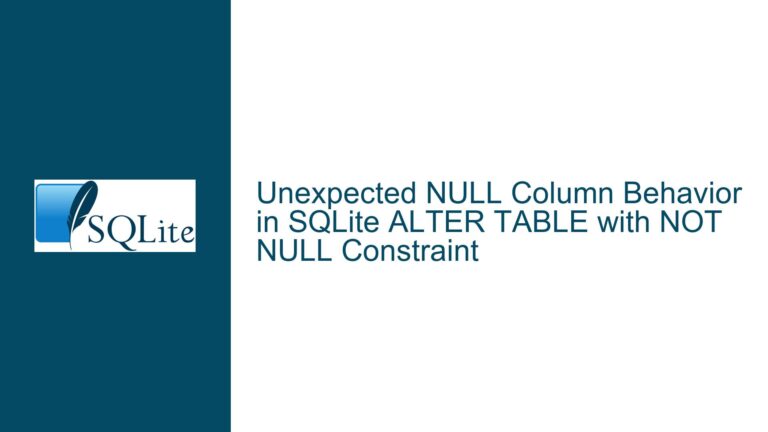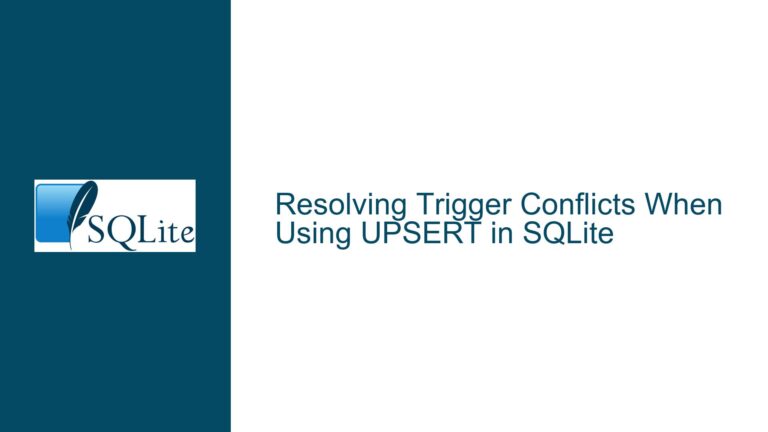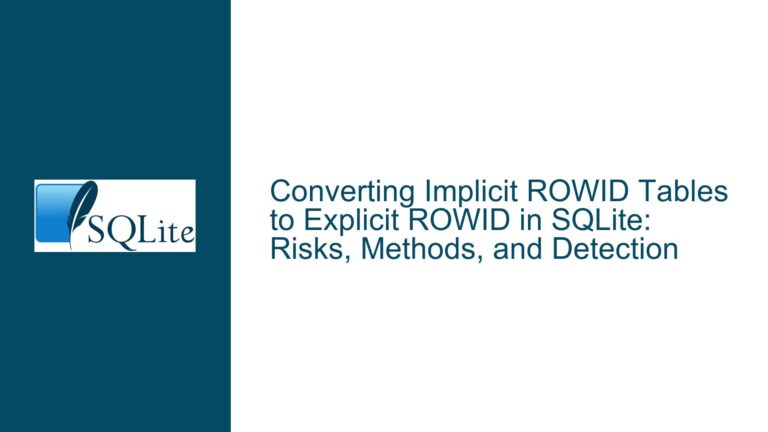Fragmentation Reduction in SQLite: Benefits vs. Modern Storage Realities
Fragmentation Claims and Modern Storage Medium Characteristics
Issue Overview
The core debate revolves around whether SQLite database fragmentation (non-contiguous page allocation) negatively impacts performance, file size efficiency, and storage access patterns in modern environments. The original proposal for a PRAGMA page_block_size argues that fragmentation causes three key problems: inefficient data access, increased file sizes, and degraded performance. A counterargument challenges these claims by asserting that solid-state storage media (SSDs, embedded devices) inherently mitigate fragmentation impacts through wear-leveling algorithms and virtualized block mapping, rendering traditional fragmentation concerns obsolete. This raises critical questions about the relevance of SQLite’s page allocation strategies for contemporary hardware and whether block-based preallocation provides measurable benefits.
The discussion hinges on three technical dimensions:
- The relationship between logical page fragmentation and physical storage behavior on SSDs
- SQLite’s existing mechanisms for managing free pages (Freelist) and vacuum operations
- The practical trade-offs of preallocating contiguous page blocks versus relying on storage-layer optimizations
Key entities include SQLite’s pager module (which manages page allocation), the Freelist (tracking unused pages), incremental vacuuming (partial reorganization), and the proposed page_block_size PRAGMA. The disagreement stems from differing assumptions about how storage hardware abstracts logical vs. physical block placement and whether SQLite’s internal page management should adapt to these abstractions.
Storage Medium Behavior and Fragmentation Impact Analysis
Possible Causes
The skepticism about fragmentation’s impact arises from several intersecting factors:
1. Solid-State Storage Characteristics
SSDs use flash translation layers (FTL) to map logical block addresses (LBAs) to physical NAND locations. This layer performs wear-leveling, garbage collection, and bad block remapping, decoupling logical fragmentation from physical layout. Sequential logical reads/writes do not guarantee sequential physical access, and the FTL may scatter pages across dies/channels to parallelize I/O. Consequently, a fragmented SQLite database file might not translate to fragmented physical access patterns, as the SSD controller reorganizes data transparently.
2. SQLite’s Freelist Management and Vacuuming
SQLite’s Freelist tracks pages freed by DELETE operations, reusing them for new allocations. Incremental vacuuming removes Freelist pages from the end of the database file, reducing file size but leaving internal gaps. A full vacuum rebuilds the entire database contiguously. However, if new allocations frequently reuse Freelist pages scattered throughout the file, logical fragmentation increases. The page_block_size proposal aims to cluster these allocations per schema object, but SSDs might negate the need by masking access latency.
3. Workload-Specific Performance Factors
Fragmentation penalties depend on access patterns. Random reads/writes on a fragmented database could incur higher latency on HDDs due to seek times, but SSDs exhibit near-uniform access times regardless of LBA order. However, write amplification (a side effect of SSD garbage collection) might increase if SQLite’s page updates force the FTL to move more data blocks than necessary. Contiguous page allocation could reduce write amplification by aligning SQLite’s logical writes with the SSD’s erase block sizes (typically 128–512 KiB).
4. File Size Growth Dynamics
SQLite preallocates database file space in chunks to reduce filesystem metadata overhead. Fragmentation within these preallocated regions does not increase file size, but Freelist pages at the end of the file prevent truncation until incremental vacuuming. The proposal’s claim about larger file sizes assumes mid-file fragmentation (non-reusable gaps), but SQLite’s append-only allocation for new data might limit this effect.
5. Concurrency and Locking Overheads
Block-based allocation could reduce contention during vacuuming by localizing locks to specific page blocks. However, SSDs’ inherent parallelism might render per-block locking unnecessary, as concurrent I/O operations can be distributed across multiple NAND channels.
Resolving Fragmentation Myths and Optimizing SQLite for Modern Hardware
Troubleshooting Steps, Solutions & Fixes
1. Assessing Fragmentation Impact on SSDs
To validate whether fragmentation affects performance:
- Benchmark fragmented vs. defragmented databases: Use a workload simulating typical operations (INSERT/UPDATE/DELETE) on both HDDs and SSDs. Measure transaction throughput, latency, and I/O operations (e.g., using
PRAGMA integrity_check,sqlite3_analyzer). - Monitor SSD controller metrics: Tools like
smartctlor vendor-specific utilities can report write amplification, wear leveling counts, and erase block cycles. Higher values suggest inefficient write patterns exacerbated by fragmentation. - Inspect logical vs. physical I/O patterns: On Linux,
blktracecan trace physical block addresses accessed during SQLite operations. Compare with the database’s logical page layout to detect FTL remapping effects.
2. Optimizing Page Allocation Without Block Preallocation
If SSDs mitigate fragmentation penalties, consider these alternatives:
- Adjust SQLite’s page size: Use
PRAGMA page_size=8192to align with SSD erase blocks, reducing write amplification. Larger pages increase I/O granularity but improve sequential access. - Tune incremental vacuuming: Set
PRAGMA incremental_vacuum(N)to aggressively truncate Freelist pages, preventing file size bloat. - Leverage filesystem features: On ZFS/Btrfs, enable compression or COW (copy-on-write) to reduce physical storage footprint. On Windows, use NTFS sparse files for large databases with many gaps.
3. Implementing Block-Based Allocation Strategically
If testing confirms fragmentation issues on specific hardware:
- Use
PRAGMA page_block_sizeexperimentally: Start with small blocks (e.g., 32 pages) and monitor vacuum efficiency. Avoid oversized blocks that waste space for small tables. - Combine with schema partitioning: Store high-churn tables/indexes in separate databases attached via
ATTACH DATABASE, applying block allocation only where needed. - Preallocate database regions: SQLite’s
SQLITE_FCNTL_CHUNK_SIZEfile control can hint the VFS to allocate contiguous file regions, cooperating with the storage stack.
4. Addressing File Size Concerns
- Monitor Freelist page distribution: Query
sqlite_schemaandfreelist_countto identify objects with high page turnover. Target incremental vacuuming after bulk deletes. - Use
PRAGMA auto_vacuum=FULL: This mode trims Freelist pages automatically but increases write overhead during transactions. - Avoid over-indexing: Reduce index count on volatile tables to minimize page fragmentation across multiple B-trees.
5. Concurrency and Locking Adjustments
- Isolate vacuum operations: Schedule full vacuums during low-activity periods. Use WAL mode (
PRAGMA journal_mode=WAL) to reduce blocking during maintenance. - Profile lock contention: SQLite’s
sqlite3_lock_status()API reveals lock wait times. If page_block locking reduces contention, implement it for critical tables.
6. Hardware-Specific Tuning
- Align SQLite with SSD geometry: Configure
page_sizeandcache_sizeto match SSD erase block size and DRAM cache capabilities. - Enable I/O parallelism: Use
PRAGMA threads=Nto allow concurrent page writes, leveraging SSD channel parallelism. - Consider storage-layer encryption: Hardware-accelerated encryption (e.g., OPAL SSDs) can offload encryption overheads, mitigating any residual fragmentation penalties.
Conclusion
The relevance of SQLite fragmentation depends on the storage stack’s ability to abstract physical data placement. While page_block_size offers a structured approach to page allocation, its benefits must be validated against modern hardware behavior. A hybrid strategy—combining selective block allocation, schema optimization, and storage-aware tuning—provides the most robust solution across diverse environments.






